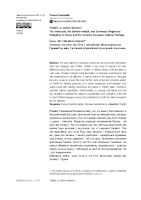Yiddish, or Jewish German? The Holocaust, the Goethe-Institut, and Germany’s Neglected Obligation to Peace and the Common European Cultural Heritage
Translated Title
Ідыш, або габрэйскі нямецкі?1Халакост, Інстытут імя Гётэ, і занядбанае абавязацельства Германіі да міру і агульнай эўрапейскай культурнай спадчыны
Author(s)
Publication Name
Publication Date
Abstract
The vast majority of Holocaust victims and survivors were Ashkenazim. Their main language was Yiddish. Yiddish is very close to German, the main difference being that the former is written in Hebrew letters, while the latter in Latin ones. Postwar Europe’s moral foundation is Holocaust remembrance. But this remembrance to be effective, it must be active in the absence of Holocaust survivors. A way to ensure that could be the novel school and university subject of Yiddish for reading purposes. As a result, researchers and interested Europeans would start reading documents and books in Yiddish again. Germany’s premiere cultural organization, Goethe-Institut, is uniquely well-placed and morally obligated to facilitate the relaunch, popularization and cultivation of the skill to read Yiddish-language sources and publications for both the sake of research and for pleasure.
Translated Abstract
Пераважная большасць ахвяр і тых, хто выжыў, былі ашкеназі. Іх асноўнай мовай быў ідыш. Ідыш вельмі блізкі да нямецкай мовы, галоўнае адрозненне заключаецца ў тым, што першая напісана іўрытскімі літарамі, а другая – лацінскімі. Маральны падмурак пасляваеннай Еўропы – па-мяць пра Халакост. Але гэта памяць для таго, каб быць эфектыўнай, яна павінна быць актыўнай у адсутнасць тых, хто перажыў Халакост. Спо-соб гарантаваць гэта можа быць новы школьны і університецькі пред-мет ідыш для чытання. У выніку даследчыкі і зацікаўленыя эўрапейцы зноў пачнуць чытаць дакументы і кнігі на ідыш. Прэм’ерная культурная арганізацыя Германіі, Інстытут імя Гётэ, мае унікальнае становішча і ма-ральна абавязана садзейнічаць перазапуску, папулярызацыі і развіццю навыку чытання крыніц і публікацый на ідыш як для даследаванняў, так і для задавальнення
Topics
Main Topic: Holocaust and Memorial Holocaust Holocaust Education Jewish Heritage Yiddish Universities / Higher Education
Genre
Geographic Coverage
Copyright Info
The work is available under the Creative Commons Attribution license 4.0
Original Language
Volume/Issue
18(2)
DOI
Note
The author chooses to include an abstract in Belarusian to express solidarity with the prodemocracy protesters in Belarus, 2020–21.
Link
Link to article including link to pdf, Yiddish, or Jewish German? The Holocaust, the Goethe-Institut, and Germany’s Neglected Obligation to Peace and the Common European Cultural Heritage
Bibliographic Information
Yiddish, or Jewish German? The Holocaust, the Goethe-Institut, and Germany’s Neglected Obligation to Peace and the Common European Cultural Heritage. 2021: https://archive.jpr.org.uk/10.31261/SSP.2021.18.14




